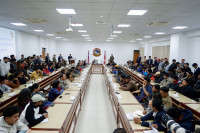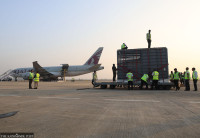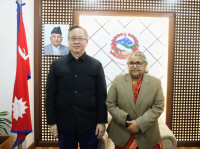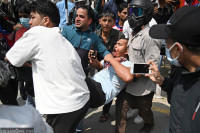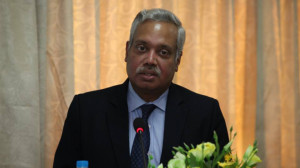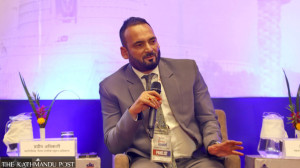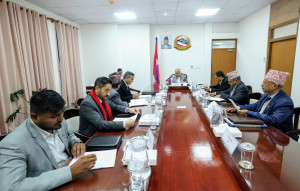National
Nepali students face uncertainty as US tightens visa rules
Suspension of interview appointments prompts many to reconsider study plans.
Sudip Kaini
Nepali students planning to study in the United States have been thrown into uncertainty after the Donald Trump administration imposed tighter restrictions on international student visas.
According to the Ministry of Education, the US remains among the top five preferred destinations for Nepali students, alongside Japan, Canada, Australia, South Korea, and the United Kingdom. However, recent directives from the Trump administration have tightened rules not only for non-resident foreigners but also for student visa applicants.
The US State Department has instructed its embassies not to grant interview appointments for student visa applicants until further notice. While interviews already scheduled are allowed to proceed, new applicants have been barred from obtaining interview dates, affecting aspiring international students globally.
A directive issued by US Secretary of State Marco Rubio instructed diplomatic missions to suspend student visa interviews unless otherwise notified. The move marks a significant break from the standard practice of embassies conducting in-person interviews before issuing student visas.
The impact of the policy shift is already being felt in Nepal. Bishnu Hari Pandey, former president of the Educational Consultancy Association of Nepal (ECAN), said students are cancelling plans to study in the US and exploring alternative destinations or considering higher education within Nepal. “This also creates an opportunity for Nepali universities and colleges,” he said.
Pandey noted that the number of Nepali students seeking US visas had dropped sharply even before the new instructions, with many applicants failing to attend scheduled interviews. “Interest in studying in the US has declined to near zero,” he said. “Ever since Trump came to power, students have been hesitant. Now, the embassy isn’t even issuing interview dates.”
Many Nepali students pursue IT, engineering, and research-oriented disciplines abroad. According to the Ministry of Education, around 8,000 students obtained No Objection Certificates (NOC) to study in the US during the current fiscal year. In the earlier fiscal year, the figure was 12,000, compared with 6,500 in 2022-23 and 8,000 in 2021-22.
Baikuntha Prasad Aryal, joint secretary at the Ministry’s Higher Education Division, said while the current period does not coincide with peak admissions, the restriction may impact future applications. “Student pressure for NOCs usually rises from August to November after grade 12 results are published,” he said. “We are still issuing NOCs for completed applications, and the US does not face the same volume as Japan or South Korea.”
Consultancy operators say the highest uncertainty is among students who recently completed grade 12 and were preparing to apply for the US. Many have taken TOEFL, IELTS, and PTE classes, but are unsure whether they can submit applications.
ECAN president Sheshraj Bhattarai warned that while immediate effects may be limited, hundreds of students preparing for US study could be affected. “Students and parents are confused. Even those on scholarships haven’t received visas,” he said. “The situation affects both affluent students who pay their way and low-income students reliant on scholarships.”
Bhattarai added that some students would seek alternatives, while many may simply wait. “Both students and we believe this situation won’t remain as it is,” he said. “Many who planned to go to the US will likely enrol in Nepali institutions while waiting. How long can US universities go without international admissions?”
In addition to consultancy-based applications, many Nepali students apply directly to colleges and universities. Nepali students are estimated to make up around two percent of international student enrolments in US institutions for the 2023-24 academic year. More than 100,000 students have already obtained NOCs to study abroad this fiscal year, compared with 112,000 last year and 110,000 in 2022-23.
International media have reported that the US visa policy has caused uncertainty for students globally. The Open Doors data platform, which tracks international student mobility, said US institutions enrolled 1.1 million international students from 210 countries in 2023-24.
India and China send the highest students to the US, with 330,000 and 280,000 students, respectively. Other sources include South Korea, Canada, Taiwan, Vietnam, Nigeria, Bangladesh, Brazil and Nepal.
The US government has taken a particularly aggressive stance towards Chinese students. US Secretary Rubio has announced plans to revoke visas of students with links to the Chinese Communist Party or those studying in sensitive fields. Visa applications from Chinese and Hong Kong students will come under increased scrutiny. Earlier, President Trump had attempted to prevent prestigious institutions like Harvard University from admitting foreign students. He accused these institutions of failing to address antisemitic activities adequately. The visa restrictions are seen as part of a broader crackdown on elite academic institutions hosting international students.
However, Trump’s effort to halt admissions was overturned by US courts. William Brustein, professor emeritus at West Virginia and Pittsburgh universities, warned that the move could have serious implications for the US itself. “Harvard may survive, but we are concerned about our public universities that rely heavily on tuition and fees from international students,” he said. “It will also affect the diversity of perspectives that foreign students bring.”




 6.12°C Kathmandu
6.12°C Kathmandu
